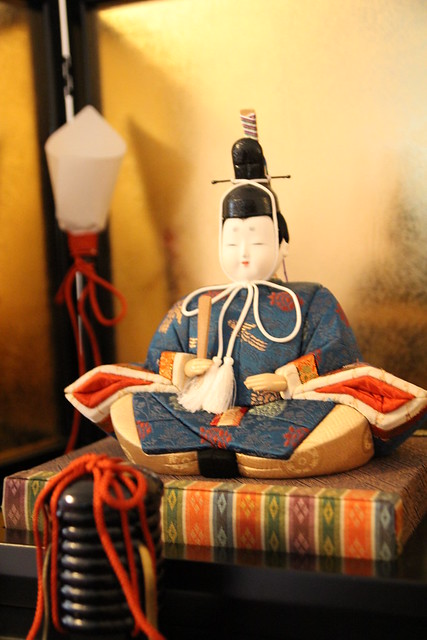Hina-matsuri, or “Girls’ Day” in Japan, is celebrated every year on March 3. While the day is a celebration of little girls everywhere, the literal translation of hina-matsuri is “The Japanese Doll Festival,” and as it suggests, a major part of the celebration involves bringing out the display of a set of ornamental dolls, called hina-ningyo in Japan. They represent the Emperor and Empress, and the more elaborate traditional sets have several platforms and include attendants and musicians in addition to the royal couple, all dressed in the traditional court dresses of the Heian period. Families who have young daughters typically display the dolls in early to mid-February and take them down immediately after Girls’ Day. It’s said that leaving the dolls up past March 4 will invite bad luck and that the daughter will marry late in life.
In Japan, virtually all families with a daughter would have a set of these dolls in their household. My mom told me about how the set that she grew up with had been one that was passed on for multiple generations so parts of the dolls were broken or had missing props, but that she and her sisters couldn’t contain their excitement and joy to see the dolls brought out every year for them. As a little girl myself, I always wanted a hina-ningyo doll set to be put on display for me, but the traditional sets can cost thousands of dollars, and were impossible to find here in the States, so there was never one in our house growing up. Last year, I considered finding one for Mio because I wanted her to be able to experience the time-honored tradition that I couldn’t have, but alas, it’s still nearly impossible to find them in the States, and while there are cheaper plush and plastic versions sold in Japan, the traditional ones are still pretty darn expensive! Factor in shipping (if they even ship to the US), and I couldn’t find anything affordable.
So imagine my surprise when last week, on Valentine’s Day, a huge package arrived on our doorstep from Japan. It was from my Aunt Chikako (my father’s sister) and her husband, Uncle Koichi. It was addressed to my father, with a letter from my aunt saying “Dear Older Brother, I would like to pass on my ohinasama set to Dan and Misono’s beloved daughter Mio.” I was honestly so surprised and excited by the unexpected gift that it overshadowed any Valentine’s Day gifts and surprises that Dan had prepared for me!


Earlier this week, I set up the display in Mio’s room, up high on top of the dresser so she couldn’t easily reach it. I did at one point pull up a chair for her to stand on so she could admire the dolls more closely (under our supervision, of course).




Mio is usually very rough in handling things like her toys and random objects, as most toddlers are, but she seemed to understand that the dolls and their accompanying props were not to be handled carelessly. She didn’t even really venture to touch anything for the first several minutes, just gazing at everything and taking it all in, occasionally poking something gently here and there.


When “viewing time” was over, there was one thing that Mio decided to snatch up as I took her off of the chair and away from the display…



February 22, 2013 @ 3:45 pm
Beautiful!
February 26, 2013 @ 5:14 pm
It is! Definitely an heirloom piece.
February 22, 2013 @ 3:53 pm
So happy to see that she has one now! i have very fond memories of my mom setting ours up and me helping her over the years. I have a feeling though that we left it out past March 4th a lot – hence the reason i’m still single X_x. It’s a sweet gesture for your family to do such a thing. simply priceless.
February 22, 2013 @ 4:17 pm
You’re so lucky you got to share that tradition with your mom! 🙂 I’m excited that it’s one I can have with Mio now. haha* Re: the superstition about the timing of taking down the dolls, when I told my grandmother about how we set up the dolls, she made sure to remind me to take them down right afterwards… which we can’t, since we’ll be in California during that time! Oh well… we’re okay with Mio not being swept away by the Proverbial Prince Charming for a while. 😉